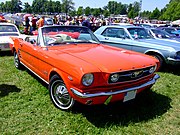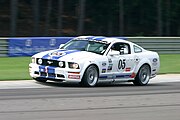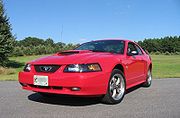









he Ford Mustang is a sports coupe manufactured by the Ford Motor Company. It was initially based on the Ford Falcon, a compact car.[1] Production began in Dearborn, Michigan on 9 March 1964 and the car was introduced to the public on 17 April 1964 at the New York World's Fair.
It was Ford's most successful launch since the Model A.[2]
Executive stylist John Najjar, who was a fan of the World War II P-51 Mustang fighter plane, suggested the name.[3][4]
The Mustang created the "pony car" class of American automobile—sports cars with long hoods and short rear decks[5] —and gave rise to competitors such as GM's Camaro[6], AMC's Javelin[7], and Chrysler's revamped Barracuda[8]. It also inspired coupés such as the Toyota Celica and Ford Capri, which were exported to America.
Mustangs grew larger and heavier with each model year until, in response to the 1971-1973 models, fans of the original 1964 design wrote to Ford urging a return to its size and concept.
The Mustang remains in production after four decades of development and revision.
| Manufacturer | Ford Motor Company |
|---|---|
| Also called | Mustang |
| Production | 1964-present |
| Assembly | USA |
| Class | Pony car |
| Body style(s) | 2-door 2+2 seat coupé 2-door convertible |
| Layout | FR layout |
First generation (1964–1973)

Conceived by Ford product manager Donald N. Frey[9][10] and championed by Ford Division general manager Lee Iacocca, the Mustang prototype was a two-seat, mid-engined roadster. This would later be remodeled as a four-seat car penned by David Ash and John Oros[11] in Ford's Lincoln–Mercury Division design studios, which produced the winning design in an intramural design contest instigated by Iacocca. To cut down the development cost and achieve a suggested retail price of US$2,368, the Mustang was based heavily on familiar yet simple components. Much of the chassis, suspension, and drivetrain components were derived from the Ford Falcon and Fairlane.
The car had the the 1964 Falcon's monocoque platform-type frame, with welded box-section side rails and cross-members.
Media exposure began on 16 April 1964 with commercials broadcast by all three American television networks to reach 29 million TV viewers, followed by announcement advertisements and publicity articles in 2,600 newspapers the next morning, the day the car was "officially" revealed.[12][13] A Mustang also appeared in the James Bond film Goldfinger in September 1964, the first time the car was used in a movie.[14][15]
Original sales forecasts projected less than 100,000 units for the first year, but in its first eighteen months, more than one million Mustangs were built.[16]
[edit] Second generation (1974–1978)
Pony cars were in disfavor by 1970, when buyers preferred cheaper, fuel-efficient compact cars. Lee Iacocca, who became president of the Ford Motor Company in December of 1970, ordered a smaller Mustang for 1974. Initially it was to be based on the Ford Maverick, a compact car similar in size and power to the Falcon, the basis for the original Mustang. In the event the smaller 1974 Mustang II was based on the Ford Pinto subcompact.
The new model was introduced two months before the first "Energy Crisis" in October of 1973—and its reduced size allowed it to compete more effectively against smaller imported sports coupés such as the Japanese Toyota Celica and the European Ford Capri (then Ford-built in Germany and Britain, sold in U.S. by Mercury as a captive import car). First-year sales were 385,993 cars, compared with the original Mustang's twelve-month sales record of 418,812. [17]
Lee Iacocca wanted the new car, which returned the Mustang to more than a semblance of its 1964 predecessor in size, shape, and overall styling,[18] to be finished to a high standard, saying it should be "a little jewel." [19] However not only was it smaller than the original car, but it was also heavier, owing to the addition of equipment needed to meet new U.S. emission and safety regulations. Performance was reduced, and despite the car's new new handling and engineering features the galloping mustang emblem "became a less muscular steed that seemed to be cantering."[20]
The car was available in coupé and hatchback versions. Changes introduced in 1975 included reinstatement of the 302CID V8 option (called the "5.0 L" although its capacity was 4.94 L) and availability of an economy option called the "MPG Stallion". Other changes in appearance and performance came with a "Cobra II" version in 1976 and a "King Cobra" in 1978.
[edit] Third generation (1979–1993)
The 1979 Mustang was based on the larger Fox platform (initially developed for the 1978 Ford Fairmont and Mercury Zephyr). The interior was restyled to accommodate four people in comfort despite a smaller rear seat. The trunk was larger, as was the engine bay, for easier service access.
Body styles included a coupé (notchback) and hatchback; a convertible was offered in 1983. Available trim levels included LX, GT, turbocharged SVO (1984-86), Cobra and Cobra R (1993).
In response to slumping sales and escalating fuel prices during the early 1980s, a new Mustang was in developement. It was to be a variant of the Mazda MX-6 assembled at AutoAlliance International in Flat Rock, Michigan. Enthusiasts wrote to Ford objecting to the proposed change to a front-wheel drive, Japanese-designed Mustang without a V8 option. The result was a major facelift of the existing Mustang in 1987, while the MX-6 variant became the 1989 Ford Probe.
[edit] Fourth generation (1994–2004)
In 1994 the Mustang underwent its first major redesign in 15 years. Code named "SN-95" by Ford, it was based on an updated version of the rear-wheel drive Fox platform called "Fox-4." The new styling by Patrick Schiavone incorporated several styling cues from earlier Mustangs. [21] For the first time a notchback coupé model was unavailable.
The base model came with a 3.8 L V6 engine with a diplacement of 232 cubic inches (3797 cc) which was rated at (1994-1995) 145 hp (108 kW) or (1996-1998) 150 hp (112 kW), or (1999-2004) 190 hp (142 kW)[22]. After nearly 40 years, Ford retired its 302 CID (5.0 L) overhead-valve small-block V8 and in 1996, the 4.6 liter (281 CID) Ford Modular engine was introduced for the first time for the Mustang rated at (215hp for 1996-1997) (225hp for 1998 model year).[23] For the 1999-2004 model year, the 4.6L V8's power output increased to 260hp.
For 1999, the Mustang received Ford's 'New Edge' styling theme with sharper contours, larger wheel arches, and creases in the bodywork, but its basic proportions remained the same as the previous redesign.
[edit] Fifth generation (2005–Present)
At the 2004 North American International Auto Show, Ford introduced a completely redesigned Mustang codenamed "S-197" and based on an all-new D2C platform for the 2005 model year. Developed under the direction of Chief Engineer Hau Thai-Tang and exterior styling designer Sid Ramnarace, the fifth-generation Mustang's styling echoes Mustangs of the 1960s, notably the 1969-70 models. Ford's senior vice president of design, J Mays, called it "retro-futurism."
The 2005 Mustang GT has an approximate weight to power ratio of 11.5 lb / bhp
The current Mustangs are manufactured at the AutoAlliance International plant in Flat Rock, Michigan. The base model has a 5-speed Tremec T-5 manual transmission. and the 210 hp (157 kW) 4.0L SOHC V6 with cast iron block replaces the 3.8L pushrod V6. The GT version has a standard 5-speed manual Tremec TR-3650 transmission with an aluminum 300 hp (224 kW) 4.6 L (281 CID) 3-valve Modular V8 with variable camshaft timing.[24] The current car is also the first Mustang to offer a 5-speed automatic (4 forward gears and overdrive), the 5R55S. Versions of this transmission have also been used in vehicles like the Ford Explorer and Lincoln LS.
The 2010 model year Mustang, due to be launched in early 2009, will be unveiled at the 2008 Los Angeles International Auto Show. [25] Little definitive detail has been revealed thus far, but it is known that the car will receive new exterior styling, with an emphasis on the front and rear fascias, an updated interior, and new powertrains.
[edit] Special editions and modified Mustangs
While the Mustang's evolution into a performance car was not foreseen at the outset, Ford has catered to individuals looking for more performance. Early higher-performance variants included the Boss 302 and the Mach 1. High performance vehicles fell out of favor during the fuel crisis of the 1970s, but Ford made them again in later years—for example the SVO, and the SVT Cobra.
For many years third-party vendors and independent car designers have modified Mustangs, and names such as Shelby, Roush and Saleen are closely associated with Mustang performance parts and customizing.[26] [27]
[edit] Racing

The Mustang made its first public appearance on a racetrack little more than a month after its April 17 introduction, as pace car for the 1964 Indianapolis 500.[4]
The same year, Mustangs achieved the first of many notable competition successes, winning first and second in class in the Tour de France international rally. The car’s American competition debut, also in 1964, was in drag racing, where private individuals and dealer-sponsored teams campaigned Mustangs powered by 427 cu. in. V8s.
In late 1964, Ford contracted Holman & Moody to prepare ten 427-powered Mustangs to contest the National Hot Rod Association's (NHRA) A/Factory Experimental class in the 1965 drag racing season. Five of these special Mustangs made their competition debut at the 1965 NHRA Winternationals, where they qualified in the Factory Stock Eliminator class. The car driven by Bill Lawton won the class.[28]
A decade later Bob Glidden won the Mustang’s first NHRA Pro Stock title.
Early Mustangs also proved successful in road racing. The GT 350 R, the race version of the Shelby GT 350, won five of the Sports Car Club of America's (SCCA) six divisions in 1965. Drivers were Jerry Titus, Bob Johnson and Mark Donohue, and Titus won the (SCCA) B-Production national championship. GT 350s won the B-Production title again in 1966 and 1967. They also won the 1966 manufacturers’ championship in the inaugural SCCA Trans-Am series, and repeated the win the following year.[4]
In 1969, modified versions of the 428 Mach 1, Boss 429 and Boss 302 took 295 United States Auto Club-certified records at Bonneville Salt Flats. The outing included a 24-hour run on a 10-mile course at an average speed of 157 miles an hour. Drivers were Mickey Thompson, Danny Ongais, Ray Brock and Bob Ottum.[4]
Boss 429 engines powered Ford Torinos in 1969 and 1970 NASCAR racing.
In 1970 the Mustang won the manufacturers’ championship in the Trans-Am series once again, with Parnelli Jones and George Follmer driving. Jones won the drivers’ title. Two years later Dick Trickle won 67 short-track feature races, a national record for wins in a single season.
In 1975 Ron Smaldone's Mustang became the first-ever American car to win the Showroom Stock national championship in SCCA road racing.
Mustangs also competed in the IMSA GTO class, with wins in 1984 and 1985. In 1985 John Jones also won the 1985 GTO drivers’ championship; Wally Dallenbach Jr., John Jones and Doc Bundy won the GTO class at the Daytona 24 Hours; and Ford won its first manufacturers’ championship in road racing since 1970. Three class wins went to Lynn St. James, the first woman to win in the series.
1986 brought eight more GTO wins and another manufacturers’ title. Scott Pruett won the drivers’ championship. The GT Endurance Championship also went to Ford.
In drag racing Rickie Smith’s Motorcraft Mustang won the International Hot Rod Association Pro Stock world championship.
In 1987 Saleen Autosport Mustangs driven by Steve Saleen and Rick Titus won the SCCA Escort Endurance SSGT championship, and in International Motor Sports Association (IMSA) racing a Mustang again won the GTO class in the Daytona 24 hours. In 1989, its silver anniversary year, the Mustang won Ford its first Trans-Am manufacturers’ title since 1970, with Lynn St. James winning the drivers’ championship. In 1997, Tommy Kendall’s Roush-prepared Mustang won a record 11 consecutive races in Trans-Am to secure his third straight driver’s championship.
In 2002 John Force broke his own NHRA drag racing record by winning his 12th national championship in his Ford Mustang Funny Car.[4]
Currently Mustangs compete in several racing series, including the KONI Challenge, where it won the manufacturer's title in 2005, and the Formula Drift and D1 Grand Prix series.
[edit] Awards
The 1965 Mustang won the Tiffany Gold Medal for excellence in American design, the first automobile ever to do so.
The Mustang was on the Car and Driver Ten Best list in 1983, 1987, 1988, 2005, and 2006. It won the Motor Trend Car of the Year award in 1974 and 1994.
In 2005 it was runner-up to the Chrysler 300 for the North American Car of the Year award and was named Canadian Car of the Year.[29]
[edit] See also
[edit] Notes
- ^ Iacocca: An Autobiography, by Lee Iacocca, Chapter VI
- ^ Hinckley, Jim (2005). The Big Book of Car Culture. MotorBooks/MBI, page 175. ISBN 9780760319659.
- ^ "Ford Mustang Prototype Failed to Appeal to the Crowds", All Ford Mustang News website, May 03 2008. Retrieved on August 25 2008.
- ^ a b c d e “Mustang Racing History”, Ford Corporate Media website. Retrieved on August 25 2008.
- ^ Mueller, Mike (1997). Ford Mustang. MotorBooks/MBI, page 21. ISBN 9780879389901.
- ^ Young, Anthony (2004). Camaro. MotorBooks/MBI, page 8. ISBN 9780760319321.
- ^ "Dick Teague" (1992). Automobile Quarterly, Volume 30 (2): page 15.
- ^ Zazarine, Paul (2002). Barracuda and Challenger. MotorBooks/MBI, page 29. ISBN 9780879385385.
- ^ "Donald N. Frey, lauteate 1990" National Medal of Technology, retrieved on August 16, 2008.
- ^ "The Thinker (Detroit Style)" Time magazine, April 21, 1967, retrieved on August 16, 2008.
- ^ Rohrlich, Marianne. "Belatedly, Stardom Finds a 20th-Century Master" The New York Times May 11, 2006, retrieved on August 16, 2008.
- ^ "1965 1966 Ford Mustang," by the Auto Editors of Consumer Guide, February 4, 2007, retrieved on August 16, 2008.
- ^ Innovative Marketing and PR Helped Build the Mustang Legend by Ford Motor Company Media, undated], retrieved on August 16, 2008.
- ^ "Trivia for Goldfinger 1964" IMDb, undated, retrieved on August 8, 2008.
- ^ "Carrera Goldfinger Racing Set Review" MI6, August 26, 2005, retrieved on August 8, 2008.
- ^ Mueller, Mike (2000). Mustang 1964-1/2-1973. MotorBooks/MBI, page 30. ISBN 9780760307342.
- ^ "1974, 1975, 1976, 1977, 1978 Ford Mustang Overview" by the Auto Editors of Consumer Guide, undated, retrieved on March 28, 2008.
- ^ Witzenburg, Gary L. (1979). Mustang!: The Complete History of America's Pioneer Ponycar. Automobile Quarterly Publications, Page 146. ISBN 9780915038251.
- ^ "The 1974 Ford Mustang: The Winning Design" 1974 1975 1976 1977 1978 Ford Mustang by the Auto Editors of Consumer Guide, February 15, 2007, retrieved on August 17, 2008.
- ^ "1974 Ford Mustang Engines and Options" 1974 1975 1976 1977 1978 Ford Mustang by the Auto Editors of Consumer Guide, February 15, 2007, retrieved on August 17, 2008.
- ^ "1994, 1995, 1996, 1997, 1998 Ford Mustang Overview" by the Auto Editors of Consumer Guide, undated, retrieved on 2008-06-08.
- ^ "The 1999 Ford Mustang Chassis and Engines" by the Auto Editors of Consumer Guide, undated, retrieved on 2008-06-13.
- ^ "The 1996 Ford Mustang" by the Auto Editors of Consumer Guide, undated, retrieved on 2008-06-08.
- ^ Ford Motor Company. Ford Media. 2005 Mustang. 2005. http://media.ford.com/products/presskit_display.cfm?vehicle_id=1052&press_subsection_id=421&make_id=92
- ^ "2010 Ford Mustang To Debut at 2008 L.A. Auto Show." Edmunds. http://www.edmunds.com/insideline/do/News/articleId=129807
- ^ ROUSH Performance - About The Company
- ^ Saleen, Inc
- ^ Morris, Charlie. "Ford's 1965 Factory Experimental Mustangs", Car Tech Inc. website, undated article. Retrieved on August 26 2008.
- ^ Ford Motor Company - Featured Story - Ford Mustang is Named 2005 Canadian Car of the Year
[edit] References
- "2005 Mustang draws inspiration from the 60's". CanadianDriver. CanadianDriver Communications, Inc.. Retrieved on 2004-01-11.
- Chilton Automotive Books (August 1, 1997). Ford Mustang/Mercury Cougar, 1964-73 Repair Manual, 1st Edition, Radnor, PA: Thomson Delmar Learning, 450. ISBN 0-8019-9060-2.
- Leffingwell, Randy (2003). Mustang Forty Years. Osceola: MBI Publishing. ISBN 0760315973.
- "The Reminiscences of L. David Ash". Automobile in American Life and Society. University of Michigan-Dearborn and The Henry Ford. Retrieved on 2005-01-30.
[edit] External links
| |||||||||||
| |||||||||||||||||







No comments:
Post a Comment